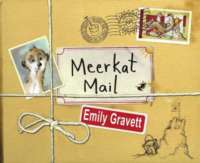
Meerkat Mail
Written by Emily Gravett
MacMillan, 2006, np.
ISBN: 978-1405090759
Author/illustrator Emily Gravett has created another endearing story full of humor and authentic insight to the natural world. Meerkat Mail is contemporary fantasy that personifies a meerkat family while keeping their story within the natural habitat and lifestyle of these animals. Sunny lives in the very hot and dry Kalahari Desert in Southern Africa within a very close family group. He decides to try living somewhere else, so leaving a note, he departs to visit other meerkat relatives in different environments. Each day for the next week he visits a different relative and readers learn of the many differences in lifestyle between the family groups: differences in food, climate, and terrain—desert vs. swamp, diurnal vs. nocturnal, and sedentary vs. nomadic. Even the family motto, “Stay safe, stay together,” doesn’t always apply to how another group deals with its predators. Sunny becomes aware of the many different types of meerkat family groups, including the mongoose family. Finally, experiencing these different environments, Sunny returns home where things are just right in the dry desert.
British author Emily Gravett’s humor and appealing lessons in the natural world occur through her art as well as the text. A winner of the 2005 Kate Greenaway Medal for Wolves, Gravett’s artistic style is unique for each book she creates, as seen in Little Mouse’s Big Book of Fears (2008) and The Rabbit Problem (2010). In Meerkat Mail, charcoal and sandy illustrations include a variety of communicative forms–family photos, newspaper clippings, postcards, and notes. Each page showing Sunny’s visit to a particular relative includes a representative laminated postcard with further information for the reader regarding that species of Meerkat. Sunny’s writing on the back of each adds a personal bit of insight as well. And, with a slight allusion to the jackal, a natural predator of the Meerkat, early in the story, readers will watch for the jackal to appear on each page of Sunny’s journey—as well as a final appearance in a travel photo at the end.
Obviously, Gravett has well researched her topic since readers can find support for the information in Meerkat Mail through Internet research as well as other information sources to support the qualities that may seem merely personification. For example, early in the story Sunny’s family is shown as living closely in working, eating, playing, learning, and sleeping. Readers can access an Animal Planet series of YouTube videos that report a 10 year study by Cambridge University. The lifestyle of this actual Meerkat family is narrated in such a way that readers realize the family within the book to be accurately represented—within the fantasy notion that allows animals to speak and travel in a human manner! These authentic videos and other sites such as that of National Geographic are intriguing and invite readers to explore further the tidbits of information that Gravett has included throughout her picture book.
Given the title, Meerkat Mail, it is no surprise that writing postcards to send home is part of this text. With a focus on this particular theme of letter writing, other books to read alongside Meerkat Mail might be The Gardener (Sarah Stewart, 1997), Dear Mr. Blueberry (Simon James, 1996), or Three Days on a River in a Red Canoe (Vera Williams, 1984). Of course, the theme of families and community—both that of working together and of being diverse—are also potential connections for young readers. Books that relate to this theme through animals include Stellaluna (Janell Cannon, 1998/2008) or Calvin Can’t Fly, The Story of a Bookworm Birdie (Jennifer Berne, 2010). One might also share the story A Blue So Blue (Jean FranCois Dumont, 2005) in thinking about the notion of traveling in search of some quest only to find it at the starting point—home.
Part of learning about the global community is discovering the natural resources and ecosystems of different geographical contexts. Meerkat Mail provides a story that invites inquiry, laughter, and perhaps a new beloved animal, the meerkat, that will lead curious readers into global communities and geographies previously unknown to them.
Janelle B. Mathis, University of North Texas, Denton, TX
WOW Review, Volume V, Issue 1 by Worlds of Words is licensed under a Creative Commons Attribution-NonCommercial-ShareAlike 4.0 International License. Based on work at https://wowlit.org/on-line-publications/review/v-1/

Thank you, Judi Moreillon, for this wonderful and thorough review.
I appreciate the connection to other books about the effects of war on children and hope, as more titles with international settings are published, young US readers’ perspective and understanding of world events continues to deepen.
Interested teachers can find a discussion guide for MY BROTHER’S SHADOW on the publisher’s website that includes a bibliography of WWI titles. http://media.us.macmillan.com/discussionguides/9780374351229DG.pdf
For teachers, students and ‘history nerds’ with an interest in primary sources I would like to recommend the website of the German History Institute in Washington, D.C.. Their digital library links to documents, images, etc., sorted by time periods, with translations and captions in English. http://germanhistorydocs.ghi-dc.org/